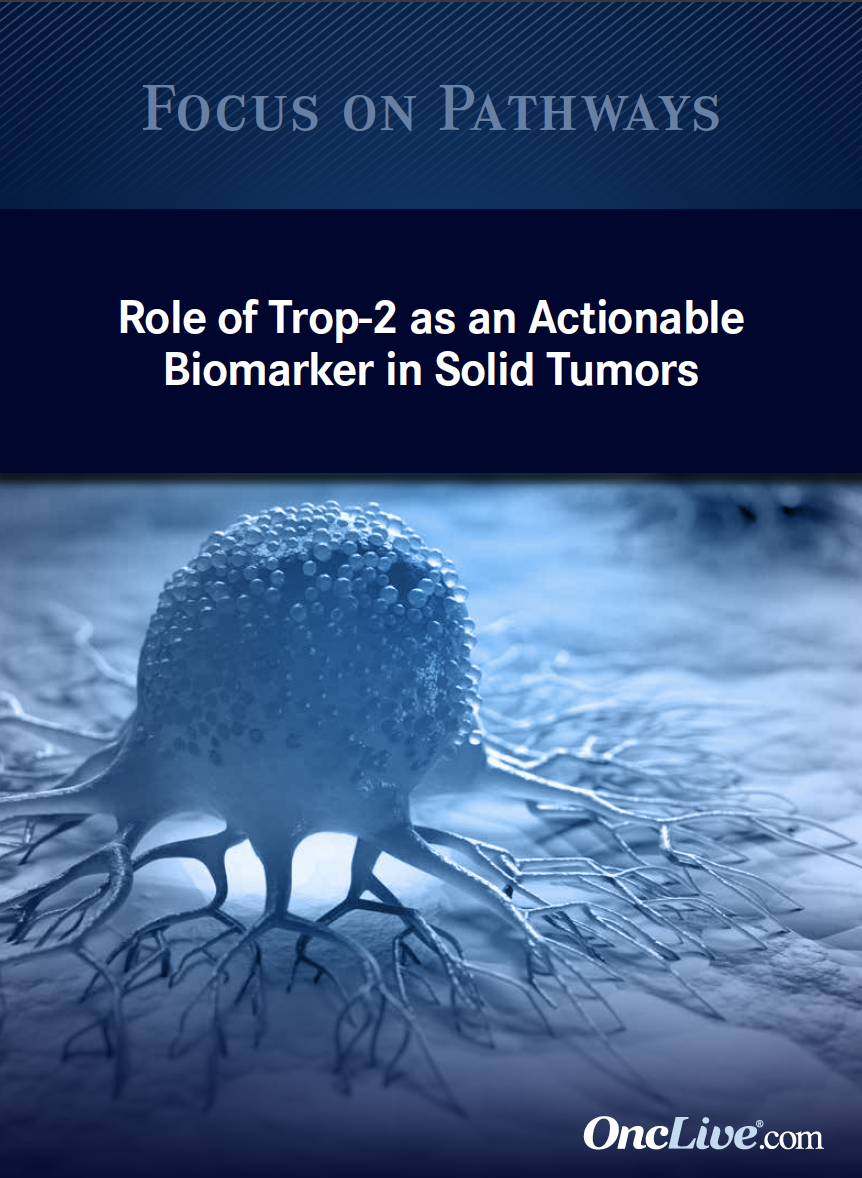ESMO 2020 Highlights With Aditya Bardia, MD, MPH
Aditya Bardia, MD, MPH, discusses the results of the ASCENT trial in triple-negative breast cancer.
Aditya Bardia, MD, MPH

Hello, on behalf of my coauthors and me, it is my pleasure to present the first results of the phase 3 ASCENT trial (NCT02574455) on sacituzumab govitecan versus treatment of physician’s choice (TPC) in patients with previously treated metastatic triple-negative breast cancer (TNBC). Because of compelling evidence of efficacy and a unanimous recommendation from the Data and Safety Monitoring Committee, the ASCENT trial was halted early.
Sacituzumab govitecan is a first-in-class antibody drug conjugate (ADC) directed toward Trop-2, which is expressed in all subtypes of breast cancer and is linked to poor prognosis. Sacituzumab govitecan has 3 components: the antibody against Trop-2, a hydrolysable linker for payload release, and the SN-38 payload, which is the active metabolite of irinotecan. Sacituzumab govitecan is distinct from other ADCs, with 3 unique properties. First, the antibody is highly specific for Trop-2. Second, the ADC has a high drug-to-antibody ratio; therefore, for every antibody, there are 7.6 molecules of SN- 38 attached to the ADC. Third, internalization and enzymatic cleavage by the tumor cell is not required for liberation of SN-38. Hydrolysis of the linker releases SN-38 extracellularly in the tumor microenvironment, providing the bystander effect.
Sacituzumab govitecan received accelerated approval from the FDA for treatment of patients with metastatic TNBC and fast track designation in metastatic urothelial cancer. The FDA was involved in the phase 1 and phase 2 trials with this agent. In patients with pretreated metastatic breast cancer, a response rate of 33% was seen, and this resulted in accelerated approval.
ASCENT was designed as a phase 3 confirmatory study of sacituzumab govitecan versus TPC for patients with refractory/relapsed metastatic TNBC. In terms of eligibility, patients with metastatic TNBC who had received at least 2 prior lines of chemotherapy for advanced disease were eligible. There was no upper limit. Prior therapies could include either neoadjuvant treatment that resulted in progression within 12 months of completion or adjuvant treatment completed as frontline.
The primary end point of the trial was progression-free survival (PFS), and the secondary end points included overall survival and objective response rate. The stratification factors were the number of prior chemotherapies, the geographic region, and the presence or absence of brain metastases. Here we present primary and secondary results, including PFS and overall survival. Additional secondary results, including biomarkers, efficacy in brain metastasis only, and the impact of the UGT1A1 genotype on safety and tolerability, will be presented in a future meeting.
Analysis of the primary end point of PFS was based on central assessment of a brain metastasis–negative patient population using a stratified log-rank test. A predefined maximum gap of 15% for patients with brain metastases was included in the trial. Assuming a hazard ratio of 0.667, a sample size of at least 488 patients would provide more than 90% power to detect statistically significant improvement in PFS, with 315 defined PFS events. The safety population included all patients with brain metastasis, positive and negative, who received at least 1 dose of treatment. The data cutoff for this analysis was March 11, 2020.
In the trial, 730 patients were screened, and 529 were randomized to receive sacituzumab govitecan or TPC, which was eribulin, capecitabine, gemcitabine, or vinorelbine; patients receiving TPC were considered the safety population. There were 235 patients without brain metastases in the sacituzumab govitecan arm and 233 in the TPC arm. This was the primary data set for efficacy analysis. The treatment discontinuation rate due to adverse events (AEs) was low. Within the TPC arm, most patients received eribulin followed by vinorelbine, gemcitabine, and capecitabine.
In terms of demographics and patient characteristics, most patients were female, with a median age of around 54 years. Most patients were White, but 12% were African American in both arms. Regarding BRCA mutation status, 7% of patients in the sacituzumab govitecan arm and 8% in the TPC arm were known to be BRCA positive. Previous lines of anticancer regimens received by the patients included all anticancer therapies, not only chemotherapy but also other targeted therapies. For patients who had hormone receptor–positive disease and became triple negative at the time of metastatic diagnosis, these also included endocrine therapy.
The median for the number of previous anticancer regimens was 4 in both arms. Regarding prior chemotherapy, 100% of patients had received taxanes, 81% had received an anthracycline, and about 66% had received prior platinum. About 25% of patients had received a prior checkpoint inhibitor. The most common sites of metastases were the lung and liver.
All subgroups derived benefit with sacituzumab govitecan, regardless of age, race, prior therapies, region, prior use of immunotherapy, liver metastases, and initial diagnosis of TNBC. A blinded independent central review analysis depicted the PFS observed in sacituzumab govitecan versus standard chemotherapy. The median PFS was 5.6 months with sacituzumab govitecan and 1.7 months with TPC. This corresponded to a hazard ratio of 0.41; therefore, there was a 59% lower risk of progression with sacituzumab govitecan than with TPC. This was highly statistically significant, with P < .0001. This was also seen by investigator-assessed PFS and across the full study population, including patients with brain metastases. Moreover, the hazard ratio was clinically meaningful and statistically significant.
Sacituzumab govitecan was associated with a significant improvement in overall survival, with a median overall survival of 12.1 months versus 6.7 months with TPC, which corresponds to a hazard ratio of 0.48. These results were both statistically significant and clinically meaningful. The objective response rate was 35% with sacituzumab govitecan and 5% with TPC. The clinical benefit rate (defined as having stable disease for more than 6 months, or objective response rate) was 45% with sacituzumab govitecan and 9% with TPC.
Regarding tolerability, sacituzumab govitecan was well tolerated, with a manageable safety profile consistent with that of previous reports. The key grade 3 or higher treatment-related AEs with sacituzumab govitecan included neutropenia, diarrhea, and anemia. In addition, 6% of patients who received sacituzumab govitecan had febrile neutropenia versus 2% of those who received TPC.
Granulocyte colony-stimulating factor usage was 49% with sacituzumab govitecan and 23% with TPC. Patients receiving sacituzumab govitecan had no severe cardiovascular toxicity and no grade 2 or higher neuropathy or grade 3 or higher interstitial lung disease. Therefore, the AEs were hematological conditions, including neutropenia and anemia, or gastrointestinal conditions, with diarrhea being the most common gastrointestinal AE seen with this agent. This is consistent with expectations because AEs are not expected with the SN-38 payload of sacituzumab govitecan.
There were no treatment-related deaths with sacituzumab govitecan, and the rate of AEs resulting in treatment discontinuation was low in both arms: 4.7% for sacituzumab govitecan and 5.4% for TPC. Overall sacituzumab govitecan was well tolerated, and the AEs were managed with either a granulocyte colony-stimulating factor for neutropenia or an antidiarrheal for diarrhea. ASCENT is the first phase 3 trial to demonstrate an improvement in PFS and overall survival with an ADC over standard therapy for patients with metastatic TNBC. This confirms that sacituzumab govitecan should be the new standard of care for patients with pretreated metastatic TNBC. Looking forward, ongoing studies are evaluating sacituzumab govitecan in earlier lines of therapy. These therapies include neoadjuvants, adjuvants, and those in combination with other targeted agents such as PARP inhibitors.
Sacituzumab govitecan is also being looked at in other breast cancer subtypes such as hormone receptor–positive breast cancer. Additionally, the TROPiCS-02 trial (NCT03901339) is looking at sacituzumab govitecan versus standard chemotherapy for patients with hormone receptor-positive metastatic breast cancer. The TROPiCS-02 trial is currently open for enrollment. I would like to thank the patients and their caregivers for their valuable contribution and commitment. We thank the dedicated clinical trial investigators and the devoted team for participating in the ASCENT trial, as this would not have been possible without their commitment and dedication. Finally, thank you to the patients, as well as to the devoted team members.
Transcript has been edited for clarity.




